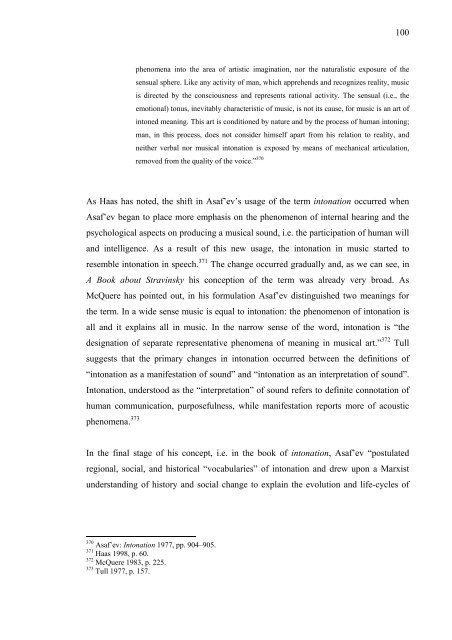Boris Asaf'ev and the Soviet Musicology - E-thesis
Boris Asaf'ev and the Soviet Musicology - E-thesis
Boris Asaf'ev and the Soviet Musicology - E-thesis
Create successful ePaper yourself
Turn your PDF publications into a flip-book with our unique Google optimized e-Paper software.
100<br />
phenomena into <strong>the</strong> area of artistic imagination, nor <strong>the</strong> naturalistic exposure of <strong>the</strong><br />
sensual sphere. Like any activity of man, which apprehends <strong>and</strong> recognizes reality, music<br />
is directed by <strong>the</strong> consciousness <strong>and</strong> represents rational activity. The sensual (i.e., <strong>the</strong><br />
emotional) tonus, inevitably characteristic of music, is not its cause, for music is an art of<br />
intoned meaning. This art is conditioned by nature <strong>and</strong> by <strong>the</strong> process of human intoning;<br />
man, in this process, does not consider himself apart from his relation to reality, <strong>and</strong><br />
nei<strong>the</strong>r verbal nor musical intonation is exposed by means of mechanical articulation,<br />
removed from <strong>the</strong> quality of <strong>the</strong> voice.” 370<br />
As Haas has noted, <strong>the</strong> shift in Asaf’ev’s usage of <strong>the</strong> term intonation occurred when<br />
Asaf’ev began to place more emphasis on <strong>the</strong> phenomenon of internal hearing <strong>and</strong> <strong>the</strong><br />
psychological aspects on producing a musical sound, i.e. <strong>the</strong> participation of human will<br />
<strong>and</strong> intelligence. As a result of this new usage, <strong>the</strong> intonation in music started to<br />
resemble intonation in speech. 371 The change occurred gradually <strong>and</strong>, as we can see, in<br />
A Book about Stravinsky his conception of <strong>the</strong> term was already very broad. As<br />
McQuere has pointed out, in his formulation Asaf’ev distinguished two meanings for<br />
<strong>the</strong> term. In a wide sense music is equal to intonation: <strong>the</strong> phenomenon of intonation is<br />
all <strong>and</strong> it explains all in music. In <strong>the</strong> narrow sense of <strong>the</strong> word, intonation is “<strong>the</strong><br />
designation of separate representative phenomena of meaning in musical art.” 372 Tull<br />
suggests that <strong>the</strong> primary changes in intonation occurred between <strong>the</strong> definitions of<br />
“intonation as a manifestation of sound” <strong>and</strong> “intonation as an interpretation of sound”.<br />
Intonation, understood as <strong>the</strong> “interpretation” of sound refers to definite connotation of<br />
human communication, purposefulness, while manifestation reports more of acoustic<br />
phenomena. 373<br />
In <strong>the</strong> final stage of his concept, i.e. in <strong>the</strong> book of intonation, Asaf’ev “postulated<br />
regional, social, <strong>and</strong> historical “vocabularies” of intonation <strong>and</strong> drew upon a Marxist<br />
underst<strong>and</strong>ing of history <strong>and</strong> social change to explain <strong>the</strong> evolution <strong>and</strong> life-cycles of<br />
370 Asaf’ev: Intonation 1977, pp. 904–905.<br />
371 Haas 1998, p. 60.<br />
372 McQuere 1983, p. 225.<br />
373 Tull 1977, p. 157.

















